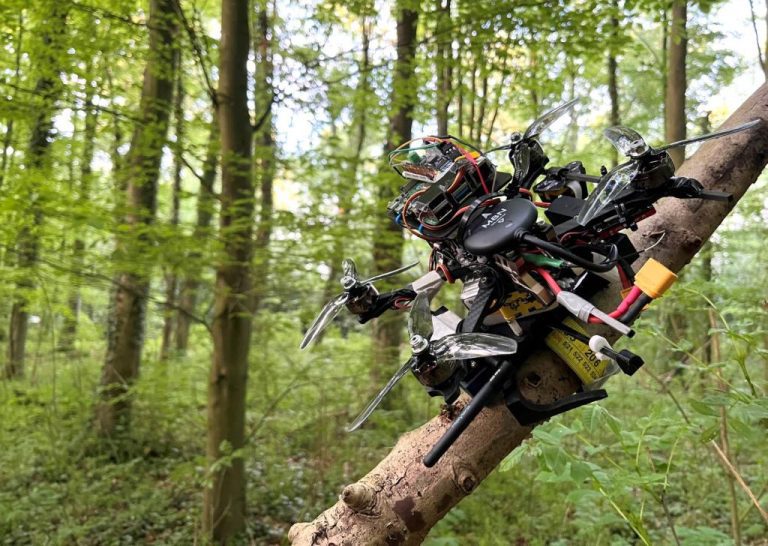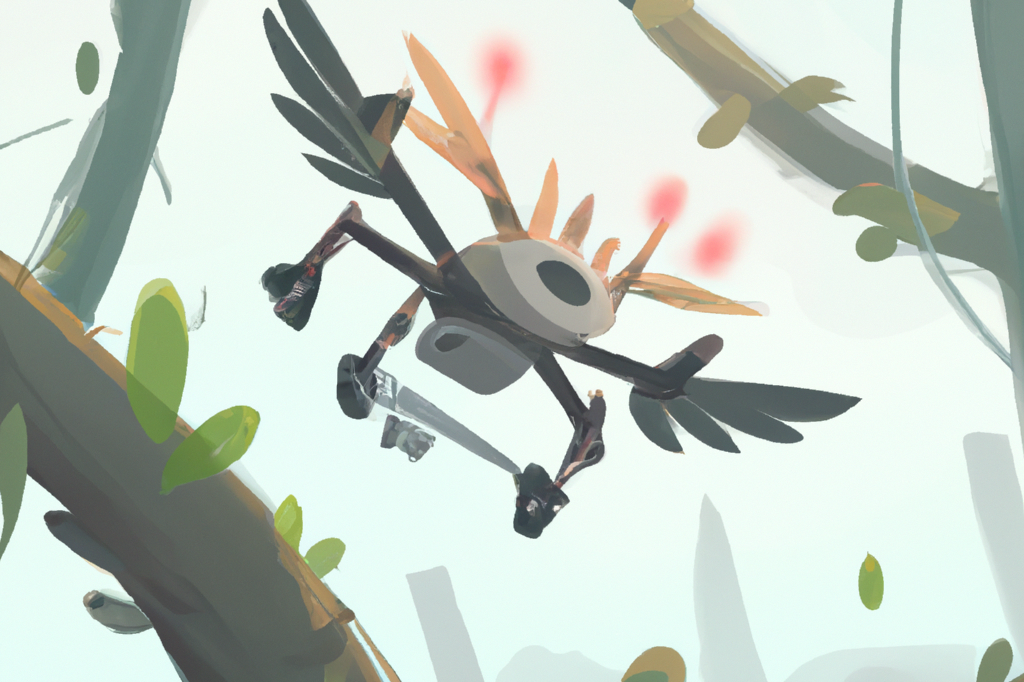Artificial intelligence is the theme at TU Delft this year. Delta explains six pieces of AI research. Part 3: How drones can help biodiversity research.
AI-generated image of a drone in the jungle. (Image via Salua Hamaza)
If you are afraid of heights, it is hard to research bioacoustics. Ecologists collecting data in rainforests sometimes have to climb up trees to 50 metres and camp there for days. This is not only time consuming, but inefficient. One ecologist alone can only study a tiny part of an immense rainforest that is also largely inaccessible to humans.
Drones could be a solution. That, at least, is the hope of Salua Hamaza, Assistant Professor of Aerial Robotics (Faculty of Aerospace Engineering) and Director of the BioMorphic Intelligence Lab, which is part of the AI Labs. Along with Co-Director Nergis Tömen and nine PhD candidates, she is working on drones that could be used for this work. This calls for certain qualities. The drone must be able to handle dense scrub and land on uneven surfaces such as tree branches.
This meant that the drone that the team used to get to the semi-finals of the XPRIZE Rainforest, a worldwide competition for new technologies in researching biodiversity in rainforests, had a claw-like mechanism. In contrast to regular drones, this allowed it to land on uneven surfaces like tree branches. After landing, the drone can turn off the propeller and collect sound data silently. Once it has collected enough, it opens its claws and flies back to the researchers.
Limbs
The biggest obstacle to reaching this future scenario is still the duration of the battery. Hamaza believes that the solution may lie in nature. “You could give drones wings, like birds. Wings could help it fly and save battery power.” But this has its challenges too. “Wings would make it harder for a drone to stay in one position when there’s wind. It would make it less stable.”
Hamaza is not working on wings. She is looking into less obvious physical qualities, such as the sense of touch, or tactile sense. This should allow a drone to feel its surroundings and thus to know what is around it, such as a wall, a tree or a leaf canopy. She received a Veni grant this year for her research into giving drones a tactile sense.
These physical additions cannot operate without AI, says Hamaza. You can give a drone claws, wings or a tactile sense, but needs to know how to handle them.

The drone that the team used to compete in the XPRIZE Rainforest competition. (Photo via Salua Hamaza)
Relevant sensations
AI should ensure that the drone can handle these extra bodily functions. A drone that can observe must be able to determine which sensations are relevant and which not. In a rainforest you want the drone to fly through the forest as safely as possible and land at a spot where it will do no damage. But jungles are always alive and change continuously. A fast and smart artificial intelligence system on board should enable the drone to quickly respond to unexpected situations and do so properly.
We are not there yet. Hamaza’s technical research and the developments in AI of her AI focused colleague Nergis Tömen should come together in the end. The drones could eventually then be used beyond just jungles. Even more so, the ecological applications about which Hamaza talks about so enthusiastically are unique in this field.
A lot of similar research that is financed by companies has nothing to do with biodiversity. Companies are more interested in having drones carry out inspections in places that are hard to reach for humans, such as windfarms at sea.
Societal impact
It is Hamaza’s greatest hope that her drones can help biodiversity research. She also hopes that her drones can be used for rescue missions, such as searching for survivors in collapsed buildings using their tactile senses. She imagines that their limbs may mean that the drones of the future may even help remove people trapped under rubble.
Hamaza also thinks of drones being used beyond the earth. She hopes that drones like hers would be used in Mars missions within 10 years. “The Mars rovers cannot fly or access narrow places, and today’s flying space robots cannot land on uneven ground. Our drones will eventually be able to do these things”.
- Also read part 1 en 2 of this series:
- Robots that navigate like humans
- How AI simulations help to make wind turbine blades lighter



Comments are closed.